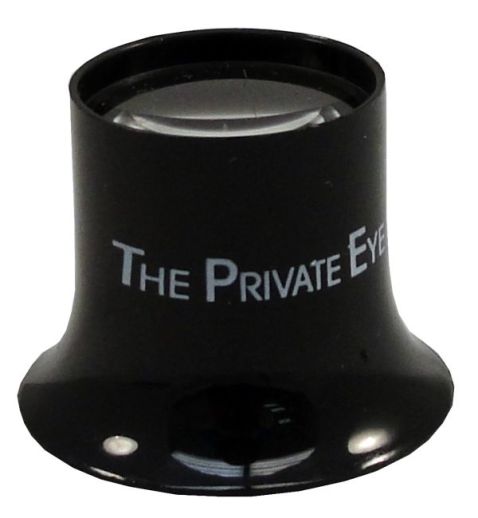We use cookies to make your experience better. To comply with the new e-Privacy directive, we need to ask for your consent to set the cookies. Learn more.
Private Eye Loupe (5X)
What is a "unit study"? Briefly, it's a thematic or topical approach to teaching as opposed to the traditional by-subject approach. Rather than teach each subject separately, a unit study attempts to integrate many or all subject areas into a unified study - usually centered around a particular subject or event. Obviously History (the study of events) and Science (the study of "things") are well-suited to unit studies, and usually form the "core" around which other subjects are integrated. Subjects like Bible, Geography, Government, English (writing), and Reading/Literature, Music, Home Economics, Life Skills, and Art, are usually easy to integrate around a core topics. Remaining subjects (Math, Phonics, Grammar, Spelling) can be integrated to some extent via related activities. Each, however, has its own "system" (progression of skills, mastery of "rules") which must be followed to some degree. Since one of the additional advantages of a unit study curriculum is the ability to use it with students of varying ages and skill levels, these subjects are generally taught apart from the core curriculum. This may be as simple as assigning pages in a grammar or spelling book, or using a separate "program" for Phonics and Math. Unit studies also tend to be more activity-oriented than the traditional approach, a real boon to kinesthetic learners. Advocates of the unit study approach site studies showing that children learn best when learning is unified rather than fragmented and when learning is more participatory than passive.
Unit study guides are like one unit of a curriculum unit study. They are meant to be used for a shorter amount of time to study a specific topic using this approach.
Talented homeschoolers are increasingly developing and producing unit studies not just for their own families, but to share with others. This is so exciting to me! For years, public school teachers have had outlets to share the products of their research and labors with fellow teachers. Now homeschoolers are doing the same - allowing others to reap the benefits. Each author has her (or his) own style - each unit study here is unique in its execution and focus. Someday, I hope this section will be brimming over with units! What a learning experience to see another perspective on a topic! For busy moms who like the unit study method but can't prepare their own from scratch, this section could become a treasure trove!
Although we receive a lot of "prospects" for this section, we try to limit our selections based on the following preferences. Basically, we avoid "no help" studies that give you little more than an outline to follow with suggested resources. Preference is given to studies that are "exciting and inviting", products of obviously thorough research and compilation, ones that provide some "meat" or base to work from (either a couple of basic resource books, or self-contained), and interesting, educational activities that are not just "busywork."
This curriculum, both fascinating and fun, covers writing skills, science, art, math, and more. But above all, this program will help them to THINK! The unique aspect of this curriculum is using a jewelers loupe to magnify your view of the world "times five" (5X). As you examine countless objects you may not have noticed before, you discover whole new worlds. The book invites you to "walk on the back of a beetle, slide down the throat of a foxglove, wade through the hairs of a bean sprout, and traipse over the back of your own hand."
First comes the part that kids look forward to the most: careful observation of the object using the loupe. Then, they carefully draw the object as they see it, using the loupe. The accuracy and quality of their drawings will surprise them, as they draw it again, larger and larger. A regularly recurring question is, "What is this like?" Making analogies, students list from 5 to 10 things that remind them of the magnified object. This builds thinking skills. Writing skills are practiced as you use these analogies in prose or poetry about the object.
The next question is, "Why is it like this?" Here's where the math and science come in. Students will begin to understand scientific principles and increase their scientific literacy as they search for the "why"s. Many objects lend themselves well to mathematics, especially geometry. God's design of nature displays symmetry and organization.
This book is usable with a wide grade range, without "stretching it." It is informative and very interesting to younger children, while older ones can build on the basics, creating unit studies and digging deeper into a subject which interests them. Regardless of age, many children, even those who are less than motivated and hard to teach, are captivated by this program. You would need a few extra resources to make this a complete curriculum (handwriting, additional math, literature), but his is a wonderful base for hundreds of fantastic unit studies. The book includes lists of recommended books from all subject areas and a list of suggested objects to view. What are you waiting for? Examine the world up-close and personal! Note: this does contain some references to evolution. Please also note that no loupes are included with the guide; loupes (and sets of loupes) are sold separately.
| Product Format: | Science Equipment / Supplies |
|---|---|
| Brand: | The Private Eye |
| Grades: | K-12 |
| Length in Inches: | 1 |
| Width in Inches: | 1 |
| Height in Inches: | 1 |
| Weight in Pounds: | 0.01 |

